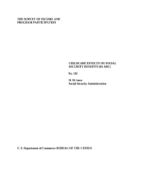
An official website of the United States government
Here’s how you know
Official websites use .gov
A .gov website belongs to an official government organization in the United States.
Secure .gov websites use HTTPS
A lock (
) or https:// means you’ve safely connected to the .gov website. Share sensitive information only on official, secure websites.
-
//
- Census.gov /
- Library /
- Census Working Papers /
- Childcare Effects on Social Security Benefits (91 ARC)
Childcare Effects on Social Security Benefits (91 ARC)
Childcare Effects on Social Security Benefits (91 ARC)
Introduction
On Mother's Day, 1990, the older Women's League (OWL) distributed a report critical of the state of older women's economic security, a system designed primarily to respond to work patterns of men and the shrinking number of stay-at-home wives with intact marriages. The OWL report indicts pension systems in general and Social Security in particular for failing to keep pace with social changes in labor force participation and family responsibility. one factor that reduces women's retired worker benefits is that women are the primary caregivers of children, the elderly, and the disabled, leading to time out of the labor force while caring for family members. Time out of the labor force can reduce substantially the size of the caregiver's resultant social security and pension benefits in old age. At the end of 1988, the basic retirement benefit newly awarded to women was 59 percent of that of men (Social Security Administration 1989, Table 6.A.2). But many women do not earn social security retired-worker benefits greater than they can receive as a wife or widow. Approximately three-fifths of older beneficiary women receive social security benefits based on their auxiliary status as wives or widows (Lingg 1990).
Gwendolyn King--the Commissioner of the Social Security Administration (SSA)--has created a women's issues task force to recommend steps to respond to equity and adequacy concerns such as those in the OWL report. One option that has been proposed by advocacy groups is providing caregiving dropout years that would allow future retirees to drop some years from the benefit calculation that were spent giving care to family members.
For analytic purposes, this paper examines the effects of a plan aimed at improving benefits for persons retiring after 1991 who had no earnings during years spent giving care for family members. This paper assesses what types of women are affected by dropout years. It also estimates the effect that dropout years would have on the size of women's benefits and, for married women, the likelihood that they will collect a larger wife or widow benefit than their own worker benefit. Because of data and time constraints, this analysis is only the beginning of analysis of the effect caregiving and dropout years could have on women’s benefits.
Others in Series
Working Paper
Working Paper
Working Paper
Share
Related Information
Some content on this site is available in several different electronic formats. Some of the files may require a plug-in or additional software to view.
 Yes
Yes
 No
NoComments or suggestions?


Top

